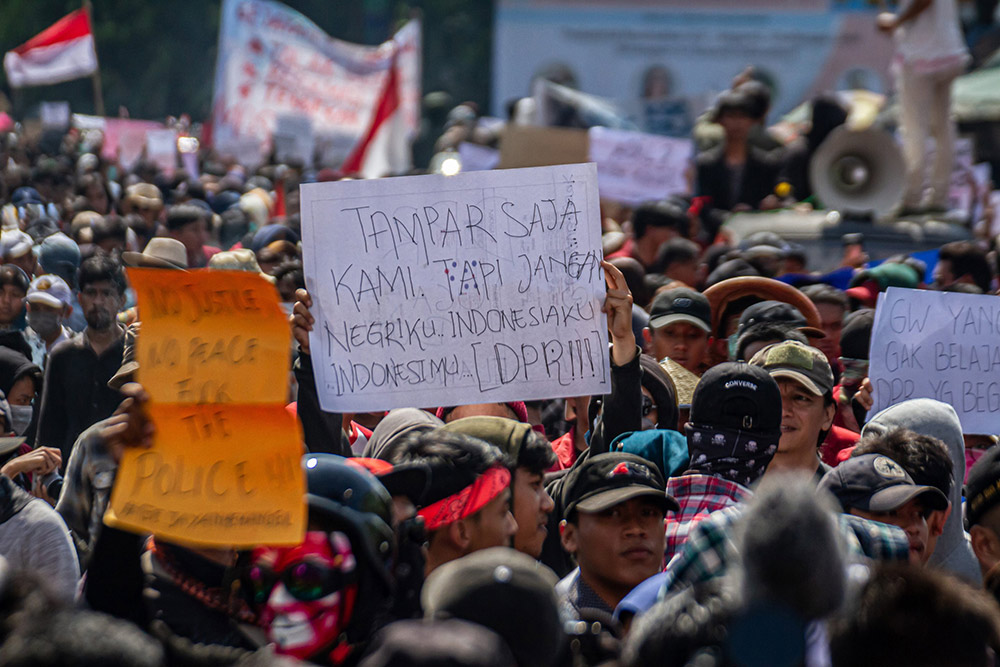
在21世纪的前十年,有一家亚洲跨国公司的首席执行官告诉我,他有全世界最好的工作。他只需要关注区域GDP和贸易增长预测,并且他可以预见自己的公司来年一定会生意兴隆。他也不需要像其他地区的公司领导人一样,需要关注政治和社会风险。他信誓旦旦地说,亚洲地区的转变势头是不可阻挡的:亚洲局势稳定,政策制定者正在积极推行实用的自由市场政策。
时间来到2021年。亚洲经济依旧在快速增长,但一些问题却令人堪忧。日益加剧的社会不平等,让亚洲的年轻人感觉与父辈相比,他们的经济机会将变得越来越少。
新冠疫情及其产生的公共卫生和经济影响,让亚洲面临更严峻的考验。中国、韩国、新加坡和越南等国家在防疫方面表现出色,但印度、印尼和菲律宾等所谓民主国家的表现却非常糟糕。
亚洲从新冠疫情中复苏的过程是一个自省的过程。我们看好的亚洲地区的未来前景,有多少是真实的呢?在新冠疫情之前,“前景光明的亚洲”成为主流叙事,有一小部分自鸣得意的亚洲精英声称,21世纪将是亚洲的世纪,但他们对亚洲面临的严峻挑战却避而不谈。
新冠疫情加剧问题。国际货币基金组织(IMF)的乔纳森•奥斯特里曾经表示,亚洲的经济产出大幅下降,年轻人和女性就业前景黯淡,可能留下“严重的创伤”。
与自然灾害和金融危机一样,新冠疫情给亚洲留下了长期无法愈合的伤疤。在社会遭到重大破坏的时期,亚州政府强有力的领导力将是解决潜在问题的关键。
亚洲还要密切关注日益加剧的社会不平等和社会阶层固化,因为有数以亿计的民众正在努力跻身中产阶级。目前对于亚洲中产阶级规模的估算被严重夸大,绝对没有达到世界经济论坛(World Economic Forum)几年前预测的惊人的17.5亿人。这是因为评论家们使用经济增长率来估算中产阶级的规模,这种方法并不准确。
事实上,亚洲有大量贫困人口和中低收入劳动者,这些底层民众向上攀登经济阶梯变得越来越难。亚洲高等教育的普及导致大学生过剩,就业前景黯淡。泰国、缅甸等地区发生的抗议,虽然主要诱因是本地的政治局势,但它们有一个共同点,就是失业和就业不足的学生走上了街头。新冠疫情的影响也暴露出亚洲城市贫困人口的困难处境。他们主要从事建筑、生产和家政等较为辛苦的工作。
气候变化将增加亚洲城市社区的压力,例如南亚和东南亚的温度上升和洪水,正在迫使更多农村人口向城市迁移。
印度早在新冠疫情爆发之前就已经问题不断,现在它只有改变偏向于亿万富翁阶层的策略,才能够恢复快速增长。越南虽然被视为亚洲经济增长的榜样,但它要想维持经济增长,必须从根本上调整经济结构,减少对本地巨头和国有企业的依赖。
我们只有消除这些隐患,才可以向世人宣告“亚洲的世纪”已经来临。(财富中文网)
本文作者瓦苏基•沙斯特里现任英国皇家国际事务研究所(Chatham House)亚洲研究员。沙斯特里曾经是一名记者,曾经在国际货币基金组织、渣打银行(Standard Chartered Bank)和新加坡央行长期任职。他是《亚洲已经走向衰败?》(Has Asia Lost It? Dynamic Past, Turbulent Future)一书的作者。
翻译:刘进龙
审校:汪皓
在21世纪的前十年,有一家亚洲跨国公司的首席执行官告诉我,他有全世界最好的工作。他只需要关注区域GDP和贸易增长预测,并且他可以预见自己的公司来年一定会生意兴隆。他也不需要像其他地区的公司领导人一样,需要关注政治和社会风险。他信誓旦旦地说,亚洲地区的转变势头是不可阻挡的:亚洲局势稳定,政策制定者正在积极推行实用的自由市场政策。
时间来到2021年。亚洲经济依旧在快速增长,但一些问题却令人堪忧。日益加剧的社会不平等,让亚洲的年轻人感觉与父辈相比,他们的经济机会将变得越来越少。
新冠疫情及其产生的公共卫生和经济影响,让亚洲面临更严峻的考验。中国、韩国、新加坡和越南等国家在防疫方面表现出色,但印度、印尼和菲律宾等所谓民主国家的表现却非常糟糕。
亚洲从新冠疫情中复苏的过程是一个自省的过程。我们看好的亚洲地区的未来前景,有多少是真实的呢?在新冠疫情之前,“前景光明的亚洲”成为主流叙事,有一小部分自鸣得意的亚洲精英声称,21世纪将是亚洲的世纪,但他们对亚洲面临的严峻挑战却避而不谈。
新冠疫情加剧问题。国际货币基金组织(IMF)的乔纳森•奥斯特里曾经表示,亚洲的经济产出大幅下降,年轻人和女性就业前景黯淡,可能留下“严重的创伤”。
与自然灾害和金融危机一样,新冠疫情给亚洲留下了长期无法愈合的伤疤。在社会遭到重大破坏的时期,亚州政府强有力的领导力将是解决潜在问题的关键。
亚洲还要密切关注日益加剧的社会不平等和社会阶层固化,因为有数以亿计的民众正在努力跻身中产阶级。目前对于亚洲中产阶级规模的估算被严重夸大,绝对没有达到世界经济论坛(World Economic Forum)几年前预测的惊人的17.5亿人。这是因为评论家们使用经济增长率来估算中产阶级的规模,这种方法并不准确。
事实上,亚洲有大量贫困人口和中低收入劳动者,这些底层民众向上攀登经济阶梯变得越来越难。亚洲高等教育的普及导致大学生过剩,就业前景黯淡。泰国、缅甸等地区发生的抗议,虽然主要诱因是本地的政治局势,但它们有一个共同点,就是失业和就业不足的学生走上了街头。新冠疫情的影响也暴露出亚洲城市贫困人口的困难处境。他们主要从事建筑、生产和家政等较为辛苦的工作。
气候变化将增加亚洲城市社区的压力,例如南亚和东南亚的温度上升和洪水,正在迫使更多农村人口向城市迁移。
印度早在新冠疫情爆发之前就已经问题不断,现在它只有改变偏向于亿万富翁阶层的策略,才能够恢复快速增长。越南虽然被视为亚洲经济增长的榜样,但它要想维持经济增长,必须从根本上调整经济结构,减少对本地巨头和国有企业的依赖。
我们只有消除这些隐患,才可以向世人宣告“亚洲的世纪”已经来临。(财富中文网)
本文作者瓦苏基•沙斯特里现任英国皇家国际事务研究所(Chatham House)亚洲研究员。沙斯特里曾经是一名记者,曾经在国际货币基金组织、渣打银行(Standard Chartered Bank)和新加坡央行长期任职。他是《亚洲已经走向衰败?》(Has Asia Lost It? Dynamic Past, Turbulent Future)一书的作者。
翻译:刘进龙
审校:汪皓
During the 2000s, a multinational CEO based in Asia told me he had the best job in the world. All he had to do was look at regional GDP and trade growth projections, and he could surmise that his business was destined for another blockbuster year. Nor did he need to worry about political and social risks, unlike his counterparts elsewhere. He assured me that the region’s transformation was unstoppable: Asia was stable and policymakers were enthusiastically pursuing pragmatic free market policies.
Fast forward to 2021. Asia still has high rates of economic growth, but social and political stability is fraying. Rising inequality has left younger Asians feeling that economic opportunity will be narrower compared with the booming generation of their parents.
The COVID-19 pandemic, and its public health and economics effects, has further tested the region. There are winners in China, Korea, Singapore and Vietnam, and countries that have stumbled, including storied democracies like India, Indonesia and the Philippines.
Asia’s emergence from the COVID-19 pandemic is a time for introspection. How much of what we boastfully declared about the region’s prospects is for real? Before the pandemic, an “Asia Shining” narrative dominated discourse as a small group of self-satisfied regional elites declared the 21st Century to be an Asian century, glossing over much of the region’s profound economic, social, and political challenges.
The problems were turbocharged by COVID-19. As the IMF’s Jonathan Ostry noted, Asia saw unprecedented declines in output and diminished job prospects for youth and women—and that “significant scarring” was likely.
Pandemics, like natural disasters and financial crises, leave long-lasting scars. Strong leadership from Asian governments will be critical in tackling fault lines.
Asia also need to pay attention to rising inequality and stalling social mobility, as hundreds of millions struggle to rise to the ranks of the middle class. Current estimates about the size of Asia’s middle class are vastly exaggerated—certainly not near the astonishing 1.75 billion that the World Economic Forum projected a few years ago—as commentators incorrectly use rates of economic growth to estimate the size of the middle class.
Instead, Asia has a vast army of poor and low-to-middle-class toilers who are finding that climbing the economic ladder is not as easy as it was in the past. The spread of higher education across Asia has created a surplus of college graduates with limited job prospects. Protests across Asia, such as those in Thailand, Myanmar and elsewhere—though driven by local political developments—have a common thread in unemployed and underemployed students taking to the streets. The fallout from the COVID-19 pandemic has also exposed the depredations of Asia’s urban poor. They toil in sectors like construction, manufacturing, and domestic labor.
Climate change will only increase pressures on urban Asian communities, as rising temperatures and flooding in South and Southeast Asia are forcing ever higher rates of emigration from rural communities.
India, which stumbled even before the pandemic, needs to transfer incentives away from the billionaire class if it is to return to high growth. Even Vietnam—the current poster child of a growing Asia—cannot hope to progress without a radical restructuring of the economy away from preferred local tycoons and state enterprises.
We cannot continue to gloss over these fault-lines in our rush to declare that an "Asian Century" has arrived.
Vasuki Shastry is an Associate Asia Fellow at Chatham House. A former journalist, he had a long career at the International Monetary Fund, Standard Chartered Bank, and Singapore’s central bank. He is the author of “Has Asia Lost It? Dynamic Past, Turbulent Future”.






